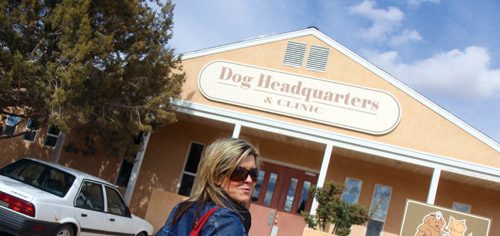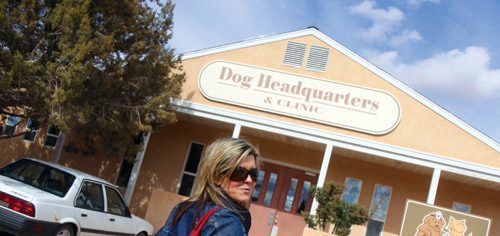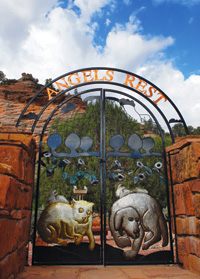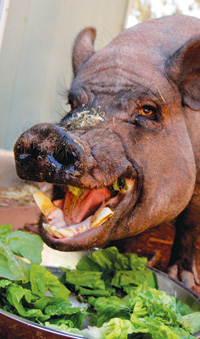

Best Friends Animal Sanctuary
Hope at the DogTown headquarters
Before my bags are unpacked, I have fallen in love with Jack. I’m not surprised, really. I knew as I was preparing for my trip to Best Friends Animal Sanctuary, location of the National Geographic Channel’s DogTown, that I would want to scoop some new pals to add to my ever-expanding ark. Somewhat aloof, Jack only warms up to me after the second sweet potato snack. Admittedly larger than most animals I have approached in the “can-Ibe- your-friend” crouch, he is nonetheless dainty as he takes the rumpled chew from my hand. The fact that people who eat with boorish abandon are called “pigs” strikes me as ironic when I look at Jack. For, though one of the sanctuary’s 21 pot-bellied residents, Jack’s polite manners exude all things gentleman. I quickly suspect similar epiphanies might end up
An easy four-hour drive from Las Vegas, the town of Kanab, Utah, is the antidote to the incessant ding-dingding of the slot machine cacophony. From the moment we pull into the sanctuary’s very welcoming Welcome Centre, an effervescent luminance radiates. The sun is beginning to set in a sky that occupies more space than I thought a sky could. Chiseled cliffs resembling scattered pieces of Paul Bunyan-sized toffees tower over the red terrain. Sets of graceful deer hop by in a well-choreographed ballet. And off in the distance, the chimes at Angel’s Rest memorial grove blow sweetly in the breeze—a reminder of the 4,000 animals who rest there in peace. All in, my boyfriend, Chad, and I are guest-starring in what I imagine an installation art show would look like were it hosted by God.
Our on-site cabin is cozy and homey, and we soon meet our first neighbour. A Katrina survivor, Pinky is staying next door on a doggie-sleepover, the pajama-party program in place to help socialize pets. While we will later host a lovely boy named Polo, a Shepherd mix from the war-torn streets of Beirut, the chew marks on our TV’s remote imply at least one such outing has already occurred here. Unless Chad got to it when I wasn’t looking. (In fairness, he hadn’t eaten in hours.) But, as idyllic as the setting is, we aren’t here to chill. We’re here to get our hands dirty. And by that, of course, I mean: play with puppies. And so the first order of business is puppy socialization class, where we teach the babies words like “sit,” “stay,” and “remote controls aren’t food.” While it’s admittedly a fun j
In any given year, Best Friends attracts approximately 25,000 visitors who help in a myriad of ways. With 800 cats, 500 dogs, and more than a handful of pigs, horses, and bunnies, there is no shortage of litters to change, laundry to fold, and bowls to fill. Cleanliness is so paramount, I see less piles of poo here than in some suburban backyards. Chad and I, on dog-walking duty, stroll trails with Namacita. Then Cooper. Then Tinkerbell. Then Knight. And then the heartwarming, lampshade-wearing Captain Muley, whose recent medical procedure forces him into the duncecap. We pass countless volunteers and wave, noting the colour of the collar sported by their four-legged pal. Like streetlights, a green collar says: “Go for it! This dog is people-friendly and may lick your face off.” A yellow collar says: “Slow down. This dog has special needs.” And a red collar says: “Stop. This dog is for staff only.” It occurs to me how people might benefit from this system, as I reflect on the pre-latté moods of some of my red-collar co-workers.
Over a vegetarian lunch buffet, a gaggle of employees heap mounds of tofu cubes onto their plates, and my inside voice lets out an involuntary: “My people! I’ve found my people!” Served in the sanctuary’s floor-to-ceiling windowed café, perched overlooking Escalante National Park’s escarpments, the daily buffet deserves its own spectacular Zagat rating. Not only for quality nosh, but for quality communications. Co-founder Cyrus Mejia passes a cordless mike from table to table in true conch-form. We hear about a Missouri puppy mill bust, potential changes to California animal welfare legislation, and plans for Best Friends’ 25-year celebrations. (The goal of this milestone
With silver anniversary celebrations underway, related events and swag abound, arguably the coolest of which is the specially produced CD collection Giving Animals a Voice Through Music featuring artists like John Oates, Cyndi Lauper, and Neko Case. After all, there’s a lot to sing about. What started a quarter century ago when a group of animal lovers simply wanted to “do more,” as co-founder Francis Battista explains, is now Mecca for all things rescue-related.
“We wanted to create something other than the tin-roof, chain-link fence, depressing local pound,” he tells me. Once the dusty set of Hollywood classics like The Lone Ranger and The Apple Dumpling Gang, today the 33,000-acre site is the largest no-kill organization in America. When I ask if he could envision this kind of success 25 years ago, he laughs. “At the time, we just put one foot in front of the other.”
Of course things were a lot different then. The no-kill movement didn’t have Today the 33,000 acres is the largest no-kill organization in America. moderndogmagazine.com 59 much in the way of volume behind its voice. In the United States alone, more than 17,000,000 animals were euthanized annually. Today, that number is 5,000,000. And while this is progress to be sure, my Macbook calculator confirms that even this improved statistic is a horrific 571 animals killed every hour. In other words, there is still work to be done. As Julie Castle, Best Friends’ director of community services and programs, admits: “Sure, it’s 
But perhaps at no time has Best Friends been more in the spotlight
than in 2007, when they were awarded custody of 22 of former NFL
player Michael Vick’s dogs—seized from his Bad Newz Kennels dogfighting
ring. The DogTown episode “Saving Michael Vick’s Dogs,”
which was nominated for a 2009 Genesis Award, documents the
sheer volume of commitment an effort of this nature requires. Eager
to meet the Vicktory Dogs, I choke back tears when I am introduced
to the lovely Georgia, the energetic Ray, and the shy Oscar. But nothing
prepares me for the way I feel when I meet Lucas. Once Vick’s
“prize fighter,” every jagged crevice on his ravaged face is evidence of
the torture he once endured, a sick reminder of a $1 billion industry.;
When I eventually sit with Dr. Mike Dix—DogTown’s own McDreamy—and his
wife, Elissa Jones, herself instrumental in coordinating episode storylines, I’m
curious if all they’ve witnessed has restored or diminished their faith in humanity.
Dr. Mike’s answer is matter-of-fact: “I see more good eggs than bad.” Elissa
recalls the letter sent from a fan in the United Kingdom addressed only to Dr
Mike Dix c/o 80 Miles North of the Grand Canyon. “And he actually got it! See?
That’s a positive,” she laughs. Now in its third season and airing in 165 countries,
the series, like the organization as a whole, is clearly making an impact.
As Chad and I prepare to leave, I experience a sadness I cannot quite name.
And while it feels an awful lot like homesickness, I know it falls more in the
camp of having to leave my long-lost tribe. A tribe that includes a chewed
remote, all-you-can-eat tofu, and my very elegant latest crush. As for you, Jack,
well, we’ll always have Utah.
To become a member of Best Friends—and to watch the new-member counter
tick—visit: celebrate.bestfriends.org.
Join the newsletter and never miss out on dog content again!
"*" indicates required fields
By clicking the arrow, you agree to our web Terms of Use and Privacy & Cookie Policy. Easy unsubscribe links are provided in every email.